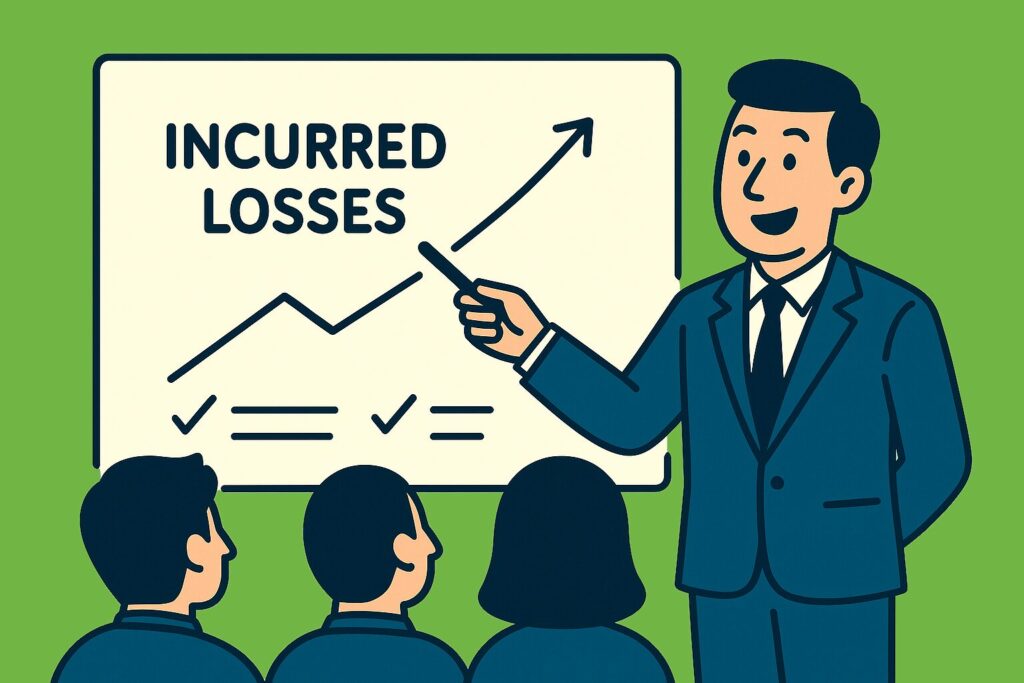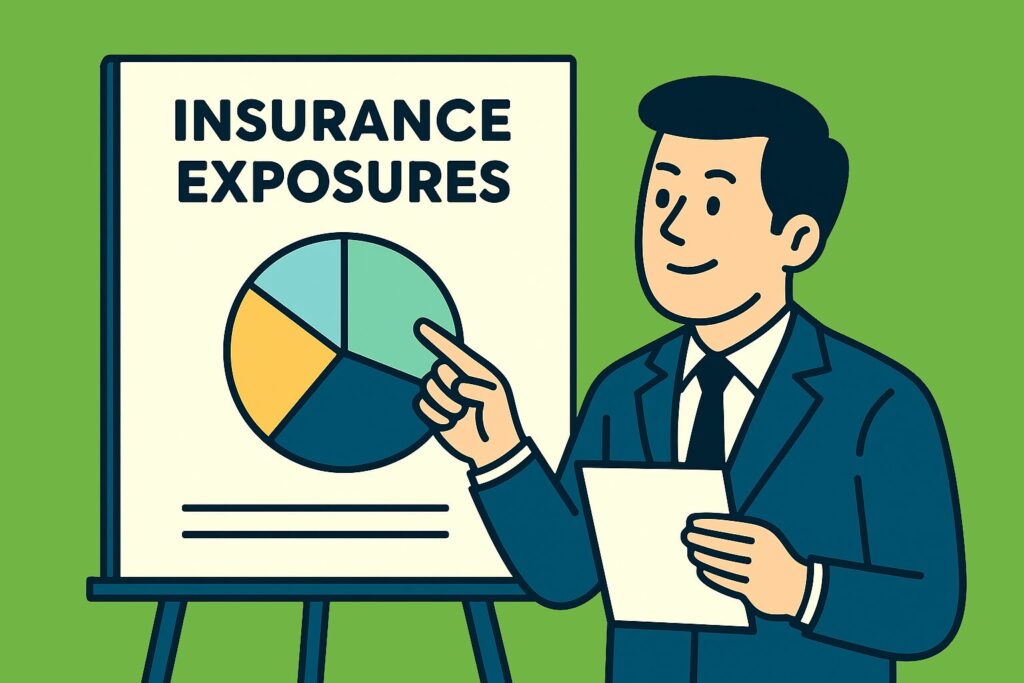Understanding Risk Exposure in the Insurance Context

Definition of Exposure vs Risk
In the insurance industry, professionals must understand the distinction between exposure and risk. The insurance exposure definition describes being vulnerable to potential losses, whereas “risk” refers to the likelihood of those losses occurring. Think of it this way: what is exposure in insurance shows us what could go wrong, while risk tells us the chances of it going wrong. Take a commercial building owner, for example—they face exposure to fire damage simply by owning the property. The actual “risk” comes down to statistics: how likely is a fire to start, based on things like what the building’s made of, what fire safety systems are in place, how it’s used, and what’s happened to similar buildings before.
Insurance professionals must clearly understand what exposures are in insurance to assess and manage potential losses accurately. You can measure exposure by looking at things like how much an asset is worth, where it’s located, and what kind of business operations happen there. This enables insurers to make more accurate predictions about potential financial losses. Risk measurement, on the other hand, uses statistical analysis, actuarial data, and predictive modeling to figure out how likely losses are and how bad they might be
Why Exposure Matters in Insurance Contracts
Insurance contracts are built around finding, measuring, and reducing exposure. Getting exposure assessments right directly affects premiums, coverage limits, deductibles, and what’s excluded from policies. Here’s an example: a manufacturing industry company working on high-rise projects faces more liability exposure than one that only builds single-family homes. When you evaluate exposure precisely, insurance providers can set fair premiums and ensure policyholders receive the right amount of coverage.
Understanding exposure in insurance examples is crucial for both insurers and policyholders. In car insurance, for instance, how much you drive affects your premiums. Home insurance considers various exposure units, such as the location of your house and its construction. Commercial insurance often requires a complex exposure analysis because businesses have numerous different operations.
Getting the exposure right doesn’t just affect pricing—it also influences reinsurance agreements. When agents misjudge exposures, insured’s may not have sufficient coverage or could face substantial losses. Properly assessing exposure helps insurers remain profitable and fosters trust between insurance companies and policyholders.
Classifying Insurance Exposures by Risk Type

Pure Risk vs Speculative Risk in Insurance
When you’re analyzing loss exposure in insurance, you need to understand two main types:
- Pure Risk: These situations have only two possible outcomes—either you lose something or you don’t. Think fires, floods, car accidents, and health emergencies. Insurance mainly deals with pure risks, acting as a safety net against things you can’t control.
- Speculative Risk: These involve three possible outcomes—you could lose money, make money, or break even. Things like investments or business ventures fall into this category. Regular insurance typically doesn’t cover speculative risks because they involve opportunities for profit, and people choose to take them on.
Diversifiable vs Nondiversifiable Risk Exposure
Understanding different types of risk exposure helps insurance professionals manage their portfolios better:
- Diversifiable Risks: These affect individuals or small groups, like a localized hailstorm or theft. Insurers handle these by spreading them across different geographic areas and various types of policies.
- Nondiversifiable Risks: These hit large populations or entire markets at once—think economic recessions, pandemics, or major natural disasters. These risks are challenging because they result in widespread claims simultaneously, so insurers require comprehensive risk transfer and pooling strategies.
Systemic vs Idiosyncratic Risk Explained
When doing insurance exposure analysis, professionals also need to think about:
- Systemic Risks: Big, economy-wide factors that affect many insured entities at once, like inflation, economic downturns, regulatory changes, or widespread cyber-attacks. These risks need strategic, industry-wide approaches to manage them.
- Idiosyncratic Risks: Specific risks tied to particular insured entities, such as one business’s operational failures or personal accidents. These get managed through individual underwriting, customized policies, and local risk assessments.
Types of Loss Exposures in Insurance

Personal Loss Exposure: Mortality and Disability
Personal loss exposures involve situations that directly affect someone’s ability to earn money or their dependents’ financial security. Life and disability insurance addresses these exposures, providing economic stability in the event of death, serious illness, or inability to work.
Insurance professionals must consider factors such as age, health conditions, job type, and lifestyle when assessing personal loss exposure. Good risk evaluation ensures that policyholders receive sufficient financial support and helps insurers set the appropriate premium levels.
Property Loss Exposure: Direct and Indirect Losses
Property loss exposure is a significant concern for homeowners, businesses, and insurance providers:
- Direct Losses: Immediate physical damage, like a fire destroying a building. Determining direct losses involves estimating repair or replacement costs based on current market prices, construction materials, and restoration expenses.
- Indirect Losses: The financial ripple effects from direct losses, including lost income from business interruption, temporary housing costs, or extra operational expenses after an insured event. Understanding indirect losses helps insurers and policyholders structure comprehensive coverage that works.
Insurance professionals also need to consider protective measures, such as fire suppression systems, security alarms, and disaster recovery plans, which can impact exposure assessments and premiums. For example, homeowner insurance policies often include optional extra coverage for specific hazards, such as earthquake coverage in high-risk areas. Home insurance considerations become even more complex when dealing with unique property features or locations.
Liability Loss Exposure: Legal and Financial Implications
Liability exposures involve being legally responsible for harm or loss you cause to other people. General liability insurance covers costs from lawsuits, medical bills, and settlements. Professionals, especially in healthcare, consulting, and construction, face significant liability exposures, which makes thorough risk assessments and strong policy provisions essential.
Liability exposure analysis should include reviewing contract obligations, industry-specific rules, and past claim patterns. When you identify potential liabilities, insurers can customize coverage effectively and reduce unexpected legal costs. Liability coverage limits are essential for mitigating the financial risk associated with potential liability claims.
Understanding the legal definition of exposure and what exposure means in law is essential for insurance professionals dealing with liability coverage. This knowledge enables an accurate assessment of the potential for legal action and the associated financial problems that may arise.
Evaluating Insurable Risks from Multiple Perspectives
Insurance Company Criteria: Definite, Measurable, Non-Catastrophic
Insurers evaluate risks based on three main criteria:
- Definite: Clearly identifiable time, location, and cause of loss, making claim assessments straightforward.
- Measurable: Quantifiable loss potential so premiums and reserves can be calculated accurately.
- Non-Catastrophic: Manageable risks that won’t financially overwhelm the insurer, supported through reinsurance and pooling strategies.
Underwriter View: Fortuitous and Shared Risk
Underwriters prefer risks that are:
- Fortuitous: Accidental and unexpected rather than intentional, which reduces moral hazard.
- Shared Risk: Spread among multiple policyholders, allowing better distribution of potential losses and ensuring financial stability for insurers.
Underwriters use detailed risk assessments, loss history, and statistical modeling tools to get precise exposure evaluations. They also consider factors such as in-force exposure and earned exposure when evaluating an insurer’s overall risk portfolio.
Risk Manager View: Cost vs Value and Risk Appetite
Risk managers balance coverage costs with the value they provide. They analyze organizational risk appetite—how much risk the organization is willing to accept. A risk-averse company might buy comprehensive cyber insurance, while a more risk-tolerant one chooses partial coverage.
Risk managers use scenario analyses, financial impact assessments, and strategic planning tools to align insurance purchases with organizational goals, maximizing coverage efficiency. They must consider various exposure units insurance and how they relate to potential insured losses in the ordinary course of business.
Catastrophic vs Accidental Loss Exposure
Understanding the difference between catastrophic and accidental loss exposure is crucial for insurance professionals:
- Catastrophic Losses: Large-scale, high-severity events like hurricanes, earthquakes, or terrorist attacks. These present challenges because of extensive claims and potential insurer insolvency.
- Accidental Losses: Random, isolated events that are easier to manage and predict using actuarial methods, letting insurers offer reliable and affordable coverage.
Properly distinguishing these exposures enables insurers to structure appropriate coverage limits, reinsurance arrangements, and premium settings.
Enterprise Risk Management and Modern Exposure Types
Enterprise Risk Mapping for Insurers
| Risk Type | Risk Example | Management Approach |
|---|---|---|
| Strategic Risk | Market shifts | Strategic planning |
| Operational Risk | IT system failures | Continuity planning |
| Financial Risk | Investment volatility | Asset diversification |
| Compliance Risk | Regulatory changes | Regular audits/compliance |
E-Risk and Cyber Exposure in Digital Insurance
Digital transformation has expanded insurers’ cyber exposure, covering data breaches, ransomware, privacy violations, and regulatory fines. Insurers must continually reassess cyber threats by utilizing advanced security measures, employee training, and comprehensive cyber insurance products tailored to evolving digital threats.
Reputation and Brand Risk in the Insurance Sector
Reputational risk encompasses potential negative publicity that can impact customer trust and financial performance. Insurance professionals must proactively manage their reputation through transparent communication, ethical practices, responsive customer service, and solid crisis response plans to minimize long-term damage.
Conclusion
Insurance exposure management forms the foundation of effective risk management, underwriting, and claims handling in the insurance industry. When you clearly distinguish between exposure and risk, classify exposure types accurately, and employ rigorous evaluation methods, you help protect both organizations and policyholders from potential financial losses. Advanced ERM strategies and proactive measures against modern exposures, such as cyber threats and reputational risks, remain critical for maintaining resilience and market trust.
Understanding how to calculate exposure in insurance and conducting thorough insurance exposure analysis are essential skills for professionals in the field. Whether you’re dealing with car insurance, homeowner’s policies, or complex commercial insurance coverage, accurately assessing and managing exposure is crucial for the success of both insurance providers and policyholders.
In the insurance industry, units with the same or similar exposure to loss are referred to as exposure units. This concept enables insurers to group and analyze risks more effectively, resulting in more accurate pricing and risk management strategies. By considering the susceptibility of various assets and operations to potential losses, insurance professionals can develop comprehensive coverage solutions that address the unique needs of each client, whether they’re in the manufacturing industry or any other sector.
The insurance exposure definition becomes even more important when dealing with specific scenarios. For instance, the loss exposure definition helps professionals understand precisely what they’re protecting against. Auto insurance exposure varies significantly based on driving habits, vehicle types, and geographic locations. Home insurance considerations encompass a wide range of factors, including natural hazards and liability risks for visitors. An insurance provider must carefully evaluate all these factors when crafting policies.
Understanding written exposure helps insurers track their total risk commitments across all policies. Various hazards can affect different types of coverage, from weather-related risks to human-caused incidents. When liability claims arise, having correctly assessed the initial exposure makes the claims process much smoother. Whether you’re working with a large insurance company or a smaller regional provider, these fundamental concepts of exposure management remain the same across the industry.

